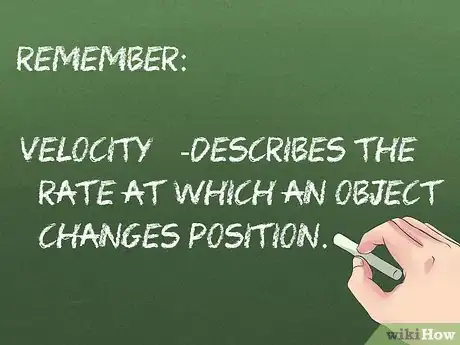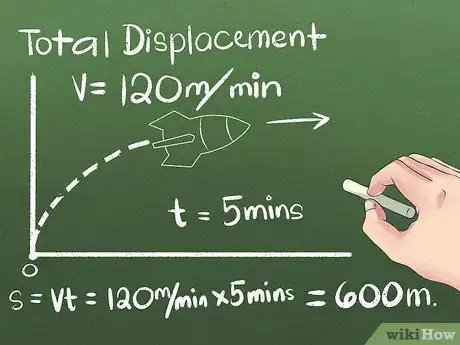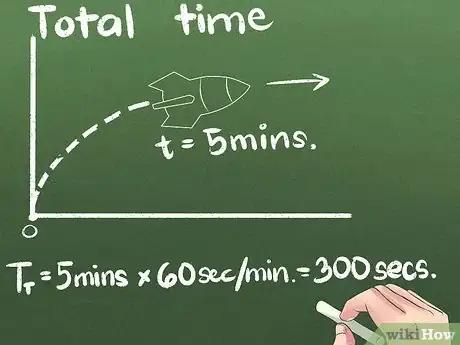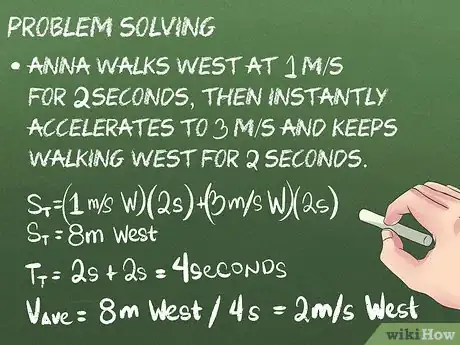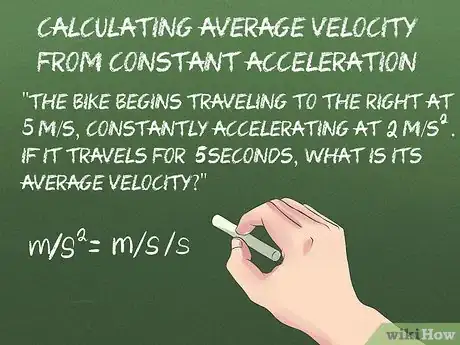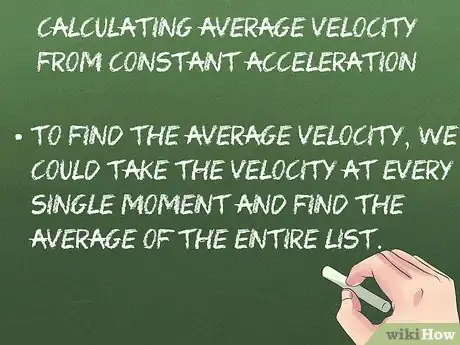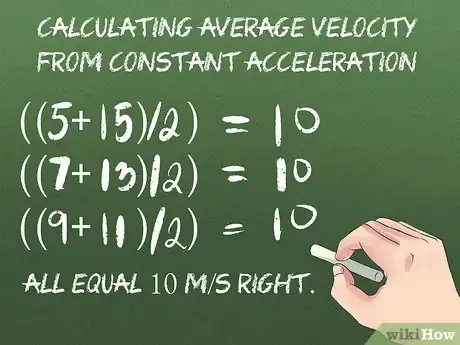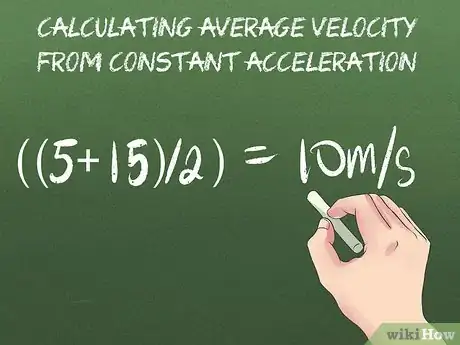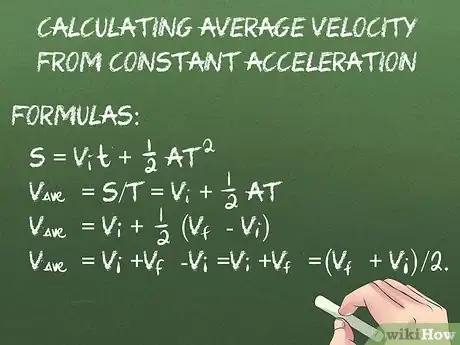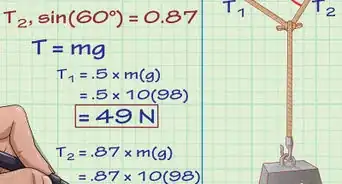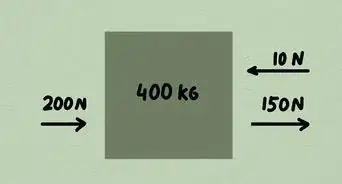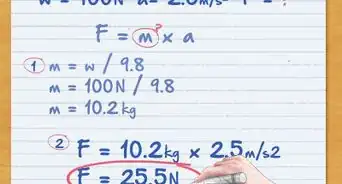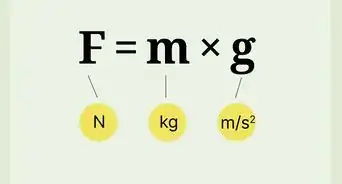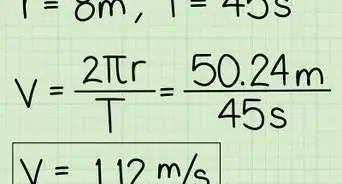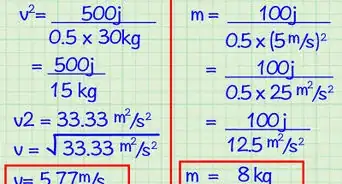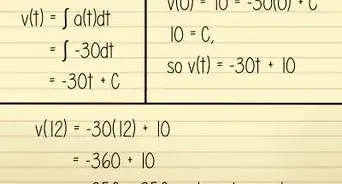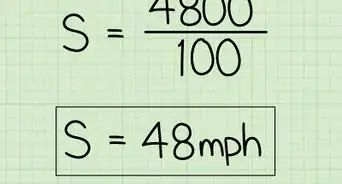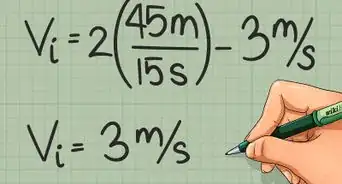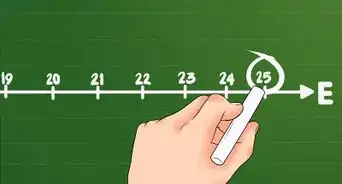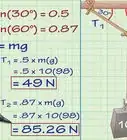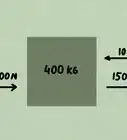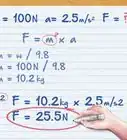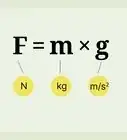This article was co-authored by wikiHow staff writer, Hannah Madden. Hannah Madden is a writer, editor, and artist currently living in Portland, Oregon. In 2018, she graduated from Portland State University with a B.S. in Environmental Studies. Hannah enjoys writing articles about conservation, sustainability, and eco-friendly products. When she isn’t writing, you can find Hannah working on hand embroidery projects and listening to music.
There are 8 references cited in this article, which can be found at the bottom of the page.
This article has been viewed 711,237 times.
Learn more...
All you need to calculate average velocity is the total displacement, or change in position, and the total time. Remember that velocity measures direction as well as speed, so include the direction in your answer, such as "north," "forward," or "left." If the problem involves constant acceleration, you can learn a shortcut that will make finding the solution even easier.
Steps
Calculating Average Velocity from Displacement and Time
-
1Remember that velocity includes speed and direction. Velocity describes the rate at which an object changes position.[1] This has to do with how fast the object is traveling, but also in which direction. "100 meters per second south" is a different velocity than "100 meters per second east."
- Quantities that include a direction are called vector quantities'.[2] They can be distinguished from directionless or scalar quantities by writing an arrow over the variable. For example, v represents speed, while v→ represents velocity, or speed + direction.[3] If a v is used in this article, it refers to velocity.
- For scientific problems, you should use meters or another metric unit of distance, but for everyday life you can use whichever unit you're comfortable with.
-
2Find the total displacement. The displacement is the object's change in position, or the distance and direction between its starting point and end point.[4] It doesn't matter where the object moved in before reaching its final position; only the distance between the start point and end point matters. For our first example, we'll use an object moving at a constant speed in one direction:
- Let's say a rocket traveled north for 5 minutes at a constant rate of 120 meters per minute. To calculate its final position, use the formula s = vt, or use common sense to realize the rocket must be at (5 minutes)(120 meters/minute) = 600 meters north of its starting point.
- For problems involving constant acceleration, you could solve for s = vt + ½at2, or refer to the other section for a shorter method of finding the answer.
Advertisement -
3Find the total amount of time spent. In our example problem, the rocket moved forward for 5 minutes. You can express average velocity in any units of time, but seconds are the international scientific standard. We'll convert to seconds in this example: (5 minutes) x (60 seconds/minute) = 300 seconds.
- Even in a scientific problem, if the problem uses units of hours or longer periods of time, it may be easier to calculate the velocity, then convert the final answer to meters/second.
-
4Calculate average velocity as displacement over time. If you know how far the object traveled, and how long it took to get there, you know how fast it was going.[5] So for our example, the rocket's average velocity was (600 meters north) / (300 seconds) = 2 meters/second north.
- Remember to include the direction (such as "forward" or "north").
- In formula form, vav = Δs/Δt. The delta symbol Δ just means "change in," so Δs/Δt means "change in position over change in time."
- Average velocity can be written vav, or as a v with a horizontal line over it.
-
5Solve more complex problems. If an object turns or changes speed, don't get confused. Average velocity is still calculated only from the total displacement, and the total time. It doesn't matter what happens in between the start point. Here are a few examples of journeys with the exact same displacement and time, and therefore the same average velocity:
- Anna walks west at 1 m/s for 2 seconds, then instantly accelerates to 3 m/s and keeps walking west for 2 seconds. Her total displacement is (1 m/s west)(2 s) + (3 m/s west)(2 s) = 8 meters west. Her total time is 2s + 2s = 4s. Her average velocity is 8m west / 4s = 2 m/s west.
- Bart walks west at 5 m/s for 3 seconds, then turns around and walks east at 7 m/s for 1 second. We can treat the eastward movement as "negative movement west," so total displacement = (5 m/s west)(3 s) + (-7 m/s west)(1 s) = 8 meters. Total time = 4s. Average velocity = 8 m west / 4s = 2 m/s west.
- Charlotte walks north 1 meter, then walks west 8 meters, then south 1 meter. It takes her 4 seconds total to walk this distance. Draw a diagram on a piece of paper, and you'll see that she ends up 8 meters west of her starting point, so this is her displacement. Total time is 4 seconds again, so the average velocity is still 8 m west / 4s = 2 m/s west.
Calculating Average Velocity from Constant Acceleration
-
1Note the initial velocity and constant acceleration. Let's say your problem is "The bike begins traveling to the right at 5 m/s, constantly accelerating at 2 m/s2. If it travels for 5 seconds, what is its average velocity?"
- If the unit "m/s2" makes no sense to you, write it as "m/s/s" or "meters per second per second."[6] An acceleration of 2 m/s/s means the velocity increases by 2 meters per second, each second.
-
2Use acceleration to find the final velocity. Acceleration, written a, is the rate of change in velocity (or speed).[7]
The velocity is rising at a constant rate of increase. You can draw a table using the acceleration to find out the velocity at different moments during this journey. We'll need to do this for the final moment in the problem (at t = 5 seconds), but we'll write a longer table to help you grasp this concept:
-
1
- At the beginning (time t = 0 seconds ), the bike is traveling right at 5 m/s.
- After 1 second (t = 1), the bike moves at 5 m/s + at = 5 m/s + (2 m/s2)(1 s) = 7 m/s.
- At t = 2, the bike is moving right at 5+(2)(2) = 9 m/s.
- At t = 3, the bike is moving right at 5+(2)(3) = 11 m/s.
- At t = 4, the bike is moving right at 5+(2)(4) = 13 m/s.
- At t = 5, the bike is moving right at 5+(2)(5) = 15 m/s.
-
2Use this formula to find average velocity. If and only if the acceleration is constant, the average velocity is the same as the average of the final velocity and the initial velocity: (vf + vi)/2. For our example, the bike's initial velocity vi is 5 m/s. As we worked out above, it ends up traveling at a final velocity vf of 15 m/s. Plugging these numbers in, we get (15 m/s + 5 m/s) / 2 = (20 m/s) / 2 = 10 m/s right.
- Remember to include the direction, in this case "right."
- These terms can instead be written as v0 (velocity at time 0, or initial velocity), and simply v (final velocity).
-
3Understand the average velocity formula intuitively. To find the average velocity, we could take the velocity at every single moment and find the average of the entire list. (This is the definition of average.) Since that would require calculus or infinite time, let's build off of this for a more intuitive explanation instead. Instead of every moment in time, let's take the average of the velocity at just two points in time and see what we get. One point in time will be near the beginning of the journey, when the bike is traveling slow, and the other will be equally close to the end of the journey, when the bike is traveling fast.
-
4Test out the intuitive theory. Use the table above for the velocities at different points in time. Some of the pairs that fit out criteria are at (t=0, t=5), (t=1, t=4), or (t=2, t=3). You can test this with non-integer values of t as well, if you like.
- No matter which pair of points we choose, the average of the two velocities at those times will always be the same. For example, ((5+15)/2), ((7+13)/2), or ((9+11)/2) all equal 10 m/s right.
-
5Finish the intuitive explanation. If we used this method with a list of every moment in time (somehow), we would keep averaging one velocity from the first half with one velocity from the second half of the journey. There's an equal amount of time in each half, so no velocities would be unaccounted for after we were finished.
- Since any one of these pairs average to the same amount, the average of all these velocities will be equal to this amount. In our example, the average of all of those "10 m/s right" will still be 10 m/s right.
- We can find this amount by averaging any one of these pairs, for instance the initial and final velocities. In our example, those are at t=0 and t=5, and can be calculated using the formula above: (5+15)/2 = 10 m/s right.
-
6Understand the formula mathematically. If you're more comfortable with a proof written as formulas, you can start with the formula for distance traveled assuming constant acceleration, and derive this formula from there:[8]
- s = vit + ½at2. (Technically Δs and Δt, or change in position and change in time, but you'll be understood if you use s and t.)
- Average velocity vav is defined as s/t, so let's put the formula in terms of s/t.
- vav = s/t = vi + ½at
- Acceleration x time equals the total change in velocity, or vf - vi. So we can replace "at" in the formula and get:
- vav = vi + ½(vf - vi).
- Simplify: vav = vi + ½vf - ½vi = ½vi + ½vf = (vf + vi)/2.
Community Q&A
-
QuestionHow do I find the average velocity?
 Community AnswerAverage velocity is the displacement divided by the time interval in which the displacement occurs . Therefore v= ∆x÷∆t.
Community AnswerAverage velocity is the displacement divided by the time interval in which the displacement occurs . Therefore v= ∆x÷∆t. -
QuestionHow would the momentum of the driver's car system change if the velocity remained unchanged but another person was in the car?
 Community AnswerP=MV. Momentum depends on the mass of the body. Even if the velocity remains unchanged, if the mass of the car varies with the addition of another person, the momentum of the car changes.
Community AnswerP=MV. Momentum depends on the mass of the body. Even if the velocity remains unchanged, if the mass of the car varies with the addition of another person, the momentum of the car changes. -
QuestionA taxi starts from rest and moves with a constant acceleration of 4m/s squared. Calculate the average velocity after 5 seconds. What's the answer to this question?
 Community AnswerAfter 5 seconds, the taxi will have a speed of 4/ms^2 x 5 s = 20 m/s. The average speed is 20 m/s / 2 = 10 m/s, because the speed increases from 0 m/s to 20 m/s in a straight line -- in such a case, the average speed is the maximum speed divided by 2. In general, Vavg is the integral of V with respect to t from Vinitial to Vfinal divided by tfinal - tinitial. In this case, V = 4t m/s, so the integral wrt t is 2t^2, which gives 2 x 25 = 50 m, divided by 5 s, = 10 m/s.
Community AnswerAfter 5 seconds, the taxi will have a speed of 4/ms^2 x 5 s = 20 m/s. The average speed is 20 m/s / 2 = 10 m/s, because the speed increases from 0 m/s to 20 m/s in a straight line -- in such a case, the average speed is the maximum speed divided by 2. In general, Vavg is the integral of V with respect to t from Vinitial to Vfinal divided by tfinal - tinitial. In this case, V = 4t m/s, so the integral wrt t is 2t^2, which gives 2 x 25 = 50 m, divided by 5 s, = 10 m/s.
References
- ↑ https://www.khanacademy.org/science/physics/one-dimensional-motion/displacement-velocity-time/a/what-is-velocity
- ↑ http://www.physicsclassroom.com/Class/1DKin/U1L1b.cfm
- ↑ https://www.khanacademy.org/science/physics/one-dimensional-motion/displacement-velocity-time/v/calculating-average-velocity-or-speed
- ↑ https://www.youtube.com/watch?v=oOcCqVzFI_s
- ↑ http://www.physicsclassroom.com/class/1DKin/Lesson-1/Acceleration
- ↑ https://www.youtube.com/watch?v=hrAOSknrYiI
- ↑ https://www.physicsclassroom.com/Class/1DKin/U1L1e.cfm
- ↑ https://www.youtube.com/watch?v=6arvL--EHJU
About This Article
To calculate average velocity from displacement and time, first find the total displacement, which is the distance and direction between the starting and ending points. Then find the total amount of time spent, and convert it to seconds, which are the international scientific standard. Finally, calculate average velocity as displacement over time by dividing the total displacement by the total amount of time. Be sure to include the direction, like “forward” or “north,” in your answer. For more information on calculating average velocity, including when you have constant acceleration, scroll down!
